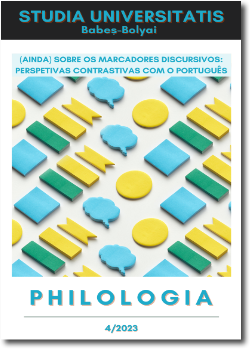A COMPARATIVE CORPUS-BASED STUDY OF EUROPEAN PORTUGUESE DISCOURSE MARKERS BOM AND BEM AND FRENCH BON AND BIEN
A COMPARATIVE CORPUS-BASED STUDY OF EUROPEAN PORTUGUESE DISCOURSE MARKERS BOM AND BEM AND FRENCH BON AND BIEN
Author(s): Fátima Silva, Fátima Oliveira, Françoise BacquelaineSubject(s): Descriptive linguistics
Published by: Studia Universitatis Babes-Bolyai
Keywords: Discourse markers; European Portuguese; French; oral corpora; semantic-discursive functions;
Summary/Abstract: A comparative corpus-based study of European Portuguese discourse markers bom and bem and French bon and bien. According to many authors, Discourse Markers (DM) serve as signals or triggers guiding the process of interpretation (Fraser 2006, Aijmer 2013, Maschler and Schiffrin 2015, among many others), thus having a more procedural than conceptual meaning. This study aims to investigate and specify the structural positions and the semantic-discursive functions of the DMs ‘bem’ and ‘bom’ in European Portuguese and of ‘bon’ and ‘bien’ in French, then to compare these positions and functions. The study relies on two European oral corpora for each language. The methodology is quantitative and qualitative. The analysis focuses primarily on the structural and modal levels, following mainly Oliveira and Silva’s (2020) proposal for the study of ‘bem’ and ‘bom’ and the proposal of Peltier and Ranson (2020) for ‘bon’. Results show that isolated DM ‘bom’ and ‘bem’ are equally frequent in the C-ORAL-ROM and that ‘bem’ is much more frequent than ‘bom’ in the local corpus Fala Bracarense. They also show that ‘bien’ is very rare as an isolated DM in both French corpora, while ‘bon’ is much more frequent than ‘bom’, ‘bem’ and ‘bien’. Regarding structural positions, these DMs occur mainly as turn medial, while structural and modal functions are more differentiated depending on the DM, the corpus and the language. Thus, the study shows that although these European French and Portuguese DMs share the same etymology, they differ in usage.
Journal: Studia Universitatis Babes-Bolyai - Philologia
- Issue Year: 68/2023
- Issue No: 4
- Page Range: 181-206
- Page Count: 26
- Language: English

